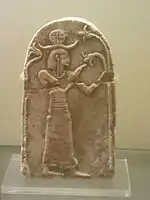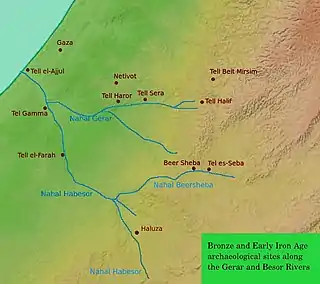

Tell Beit Mirsim is an archaeological site in Israel, on the border between the lowlands of Shfela and Mount Hebron. It is located in the eastern region of Lachish about 20 kilometers southwest of Hebron and about 13 kilometers southeast of Lachish.
Excavations
It was excavated for four seasons (1926, 1928, 1930 and 1932) by William F. Albright.[1]
The excavation revealed 10 or 11 strata dating from the late 3rd millennium BC to around 589 BC. The site is of particular importance for the archeology of Palestine, since the ceramics in the individual layers were observed particularly well and published quickly. This pottery corpus has long been considered the standard for archeology in the region.
- "The strict separation of earth layers, or archaeological sediments, also allowed the strict separation of ceramic assemblages".[2]
Town plan
_1926._Excavating_house_at_east_gate_LOC_matpc.05732.jpg.webp)
The site has "a town plan characteristic of the Kingdom of Judah that is also known from other sites" including, Beit Shemesh, Tell en-Nasbeh, Khirbet Qeiyafa and Beersheba.
- "A casemate wall was built at all of these sites and the city’s houses next to it incorporated the casemates as one of the dwelling’s rooms. This model is not known from any Canaanite, Philistine or Kingdom of Israel site."[3]
Identification of the site
Albright identified the ruin with the biblical city Dvir (Debir), or Kiryat Sefer by another name.[4] He hoped to find an ancient archive there. This identification is not currently accepted by the archaeological community. Khirbet Rabud is seen as the more likely location.[5]
References
- ↑ W. F. Albright, The Fourth Joint Campaign of Excavation at Tell Beit Mirsim, Bulletin of the American Schools of Oriental Research, No. 47 (Oct., 1932), pp. 3-17.]
- ↑ Herr, Larry G. (2002), "W.F. Albright and the History of Pottery in Palestine". Near Eastern Archaeology 65.1 (2002), 53.
- ↑ "Israel Antiquities Authority". Archived from the original on 2012-06-23. Retrieved 2014-12-20.
- ↑ Joshua, 15:15
- ↑ Trevor Bryce (2009). The Routledge Handbook of the Peoples and Places of Ancient Western Asia: From the Early Bronze Age to the Fall of the Persian Empire. Taylor & Francis. p. 588. ISBN 978-0-415-39485-7.
Bibliography
- Conder, C.R.; Kitchener, H.H. (1883). The Survey of Western Palestine: Memoirs of the Topography, Orography, Hydrography, and Archaeology. Vol. 3. London: Committee of the Palestine Exploration Fund. (pp. 279, 290)
- Ganor, Sa‘ar; Weiss, Shifra; Aladjem, Emil (2019-08-12). "Tell Beit Mirsim (South)" (131). Hadashot Arkheologiyot – Excavations and Surveys in Israel.
{{cite journal}}: Cite journal requires|journal=(help) - Gedy, Miki Ein; Golan, Karni (2007-01-14). "Tell Beit Mirsim" (119). Hadashot Arkheologiyot – Excavations and Surveys in Israel.
{{cite journal}}: Cite journal requires|journal=(help) - Guérin, V. (1869). Description Géographique Historique et Archéologique de la Palestine (in French). Vol. 1: Judee, pt. 2. Paris: L'Imprimerie Nationale. (p. 349)
- Palmer, E. H. (1881). The Survey of Western Palestine: Arabic and English Name Lists Collected During the Survey by Lieutenants Conder and Kitchener, R. E. Transliterated and Explained by E.H. Palmer. Committee of the Palestine Exploration Fund. (p. 379)
External links
- Survey of Western Palestine, Map 20: IAA, Wikimedia commons